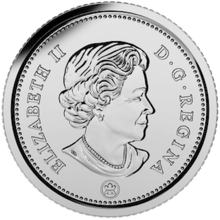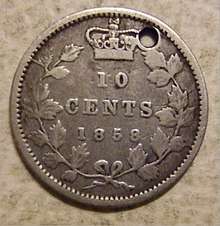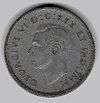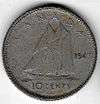Dime (Canadian coin)
In Canada, a dime is a coin worth ten cents. It has been the physically smallest Canadian coin since 1922, smaller even than the penny despite its higher face value. According to the Royal Canadian Mint, the official national term of the coin is the 10-cent piece, but in practice, the term dime predominates in English-speaking Canada. It is nearly identical in size to the American dime, but unlike its counterpart, the Canadian dime is magnetic due to a distinct metal composition: from 1968 to 1999, it was composed entirely of nickel, and since 2000, it has consisted of a steel core with plating composed of layers of nickel and copper.
Canada | |
| Value | 0.10 Canadian dollar |
|---|---|
| Mass | 1.75 g |
| Diameter | 18.03 mm |
| Thickness | 1.22 mm |
| Edge | Milled |
| Composition | Nickel-plated steel 92% steel, 5.5% Cu, 2.5% Ni plating |
| Years of minting | 1858–present |
| Catalog number | - |
| Obverse | |
 | |
| Design | Queen Elizabeth II, Queen of Canada |
| Designer | Susanna Blunt |
| Design date | 2003 |
| Reverse | |
 | |
| Design | Bluenose schooner |
| Designer | Emanuel Hahn; design based on a Wallace MacAskill photograph of Bluenose, not artwork of Hahn[1] |
| Design date | 1937 |
Currently the dime has, as with all Canadian coins, a portrait of Queen Elizabeth II on the obverse. The reverse contains a representation of the Bluenose, a famous Canadian schooner. The artist, Emanuel Hahn, used three ships including the Bluenose as his models, so the ship design is actually a composite. The coin is produced by the Royal Canadian Mint at its facility in Winnipeg.
The word dime comes from the French word dîme, meaning "tithe" or "tenth part", from the Latin decima [pars].
History of composition
| Years | Mass | Diameter/Shape | Composition[2] |
|---|---|---|---|
| 2000–present | 1.75 g | 18.03 mm | 92.0% steel (AISI 1006 alloy[3]), 5.5% copper, 2.5% nickel plating |
| 1979–1999 | 2.075 g | 18.03 mm | 99.9% nickel |
| 1969–1978 | 2.07 g | 18.03 mm | 99.9% nickel |
| 1968 | 2.07 g
2.33 g |
18.03 mm
18.034 mm |
99.9% nickel (172.5M)
50% silver, 50% copper (70.4M) |
| 1967 | 2.33 g | 18.034 mm | 50% silver, 50% copper (30.6M)
80% silver, 20% copper (32.3M) |
| 1920–1966 | 2.33 g | 18.034 mm | 80% silver, 20% copper |
| 1910–1919 | 2.33 g | 18.034 mm | 92.5% silver, 7.5% copper |
| 1858–1910 | 2.32 g | 18.034 mm | 92.5% silver, 7.5% copper |
Commemorative editions
| Year | Theme | Artist | Mintage | Special notes |
|---|---|---|---|---|
| 1967 | Canadian Centennial | Alex Colville | 62,998,215 | Features a mackerel. |
| 2001 | International Year of the Volunteer | Stan Witten | 272,465,000 | Issued in honour of the United Nations' International Year of the Volunteer. |
| 2017 | Canada 150 | Amy Choi | Commemorating the 150th anniversary of the Confederation of Canada. Features a maple leaf (titled "Wings of Peace") that forms the wings and tail of a dove. The theme of the coin is "Our Character". | |
Other notable dates






- 1936 dot: Extremely rare with only 5 known. There are 3 in private collections, one graded Specimen-63 and 2 examples graded SP-68. The other 2 are in the Ottawa currency museum. The most recent of these to sell at auction was one of the SP68 coins, which brought US$184,000 (this does not include taxes) in a Heritage Auction in January 2010.[4]
- 1969 Large Date: Fewer than 20 examples of the large date variety exist. High-grade versions of this coin sell for $15,000 to $30,000. There is only one graded in mint state as of 2012.
- 1999p: The first Canada 10-cent coin issued with the new plating "P" process. Plated coins are marked with a small "P" beneath the Queen's effigy on the obverse of the coin. Mintage is limited to 20,000 coins.
- 2000p: The 2000p Canada dime is scarce with fewer than 250 examples minted. The 2000p dime was lent to the vending industry by the Royal Canadian Mint to test the compatibility of the new plating process of circulation coins with existing vending machines and parking meters. Under contractual obligation, these coins were to be returned to the Mint once the compatibility tests were complete. Of the approximately 250 coins minted, many were not returned to the mint leading to significant debate surrounding the legality of owning these coins. High-grade examples of the 2000p 10-cent issue range from $1,500 to $3,000 CDN. Unlike the 5-cent 2000p issues, the 10-cent coin was not officially released by the Mint, and entered the numismatic market illegally.
First strikes
| Year | Theme | Mintage | Issue Price |
|---|---|---|---|
| 2005 | Bluenose | 1,861 | $14.95 |
| 2006 | With new mint mark | 5,000 | $29.95 |
References
- "Pride and skill–the 10-cent coin". mint.ca. Royal Canadian Mint. Retrieved March 30, 2020.
- "Pride and skill–the 10-cent coin". mint.ca. Royal Canadian Mint. Retrieved February 9, 2019.
- "Control of electromagnetic signals of coins through multi-ply plating technology". Google Patents. Retrieved March 3, 2020.
- "George V 10 Cents 1936 Dot". Retrieved 2020-03-28.
- Cross, W.K. (2005). Canadian Coins (59th ed.). Toronto: The Charlton Press. p. 501. ISBN 0-88968-288-7.
External links
| Wikimedia Commons has media related to Dime (Canadian coin). |